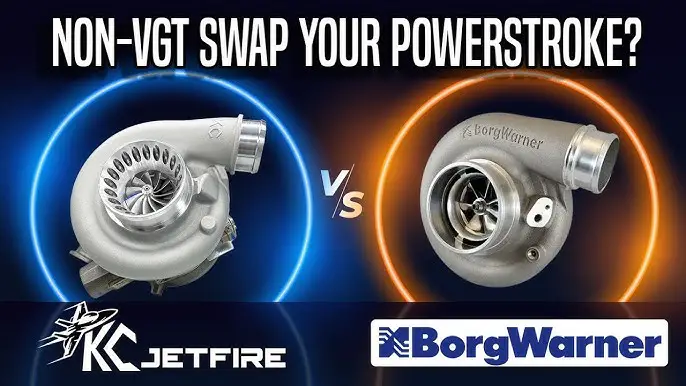VGT vs Non-VGT Turbo 6.0 Powerstroke: Ultimate Showdown
The 6.0 Powerstroke engine is popular in many trucks. It is known for its power and performance. Many people ask about two types of turbos: VGT and Non-VGT. In this article, we will explore these two turbo types. We will compare their features and benefits. This will help you understand which one is better for you.
What is a Turbocharger?
A turbocharger is a device. It helps engines produce more power. It uses exhaust gases to spin a turbine. This turbine then forces more air into the engine. More air means more fuel can be burned. This results in more power.
What is VGT?
VGT stands for Variable Geometry Turbocharger. This type of turbo has adjustable vanes. These vanes change the flow of exhaust gases. This allows for better control of boost pressure. When the engine is at low RPMs, the vanes close. This helps create more boost quickly. As the RPMs increase, the vanes open. This allows for more exhaust flow. VGT turbos work well in many situations.
What is Non-VGT?
Non-VGT turbos are simpler. They do not have adjustable vanes. They have a fixed design. This means they can be less flexible. Non-VGT turbos can create boost at high RPMs. However, they may struggle at low RPMs. This can lead to turbo lag. Turbo lag is a delay in power delivery.
Comparison of VGT and Non-VGT Turbo
| Feature | VGT Turbo | Non-VGT Turbo |
|---|---|---|
| Design | Variable geometry | Fixed geometry |
| Boost Control | Better control | Less control |
| Power Delivery | Quicker response | May have lag |
| Efficiency | More efficient | Less efficient |
| Cost | More expensive | Less expensive |
Advantages of VGT Turbo
VGT turbos have many benefits. They offer quick spool-up time. This means they produce boost faster. This is great for daily driving. They also improve fuel efficiency. More efficient engines use less fuel. This can save you money.
VGT turbos also reduce turbo lag. This means your engine responds quicker. This is helpful when you need power fast. For example, when overtaking another vehicle. You want your truck to react quickly.
Disadvantages of VGT Turbo
VGT turbos can be more complex. This means they can be harder to repair. If they break, repairs can be expensive. It is important to consider this cost.
Advantages of Non-VGT Turbo
Non-VGT turbos have their own benefits. They are simpler in design. This makes them easier to work on. Repairs are usually less expensive. They can also handle more power at high RPMs. This makes them great for racing or heavy towing.
Disadvantages of Non-VGT Turbo
Non-VGT turbos have some downsides. They can create turbo lag. This means there is a delay in power. This can make driving less enjoyable. They are also less efficient at low RPMs. This can lead to higher fuel costs.
Which One Should You Choose?
Choosing between VGT and Non-VGT turbos depends on your needs. If you want a smooth drive, go with VGT. It offers better power at low speeds. It is also more efficient. However, if you need high power for racing, consider Non-VGT. It can handle more power at high RPMs.
Cost Considerations
Cost is an important factor. VGT turbos are usually more expensive. This is due to their complex design. Non-VGT turbos are cheaper. They are easier to manufacture. You should consider your budget before making a decision.

Maintenance Tips
Maintaining your turbo is important. Here are some tips:
- Regularly check the oil level.
- Change the oil as needed.
- Inspect for any leaks.
- Clean the air filter often.
- Allow the turbo to cool down after driving.

Frequently Asked Questions
What Is A Vgt Turbo On A 6.0 Powerstroke?
A VGT (Variable Geometry Turbo) adjusts airflow for better performance. It improves power and efficiency at different speeds.
How Does A Non-vgt Turbo Work?
A non-VGT turbo has a fixed design. It boosts power but may not adapt well to changing engine needs.
What Are The Benefits Of A Vgt Turbo?
Benefits include better throttle response, improved fuel economy, and lower emissions. It adjusts to engine demands effectively.
What Are The Downsides Of Non-vgt Turbos?
Non-VGT turbos can lag at low speeds and may waste fuel. They lack adaptability compared to VGT systems.
Conclusion
In conclusion, VGT and Non-VGT turbos serve different purposes. VGT turbos offer better efficiency and quicker response. They are great for daily driving. Non-VGT turbos are simpler and cheaper. They work well for high power needs.
Think about your driving style. What do you need from your turbo? Make an informed choice. Both types have their pros and cons. Choose the one that fits your needs best.
Understanding these differences can help you make a good decision. Enjoy your driving experience with the right turbocharger!





